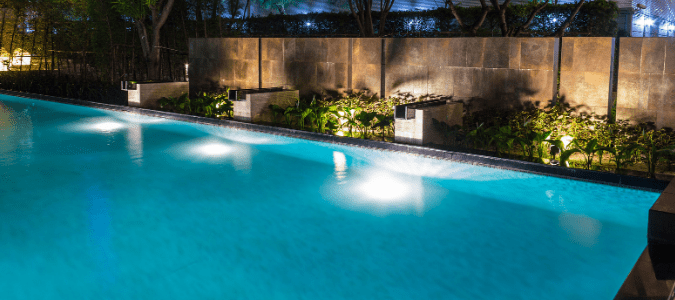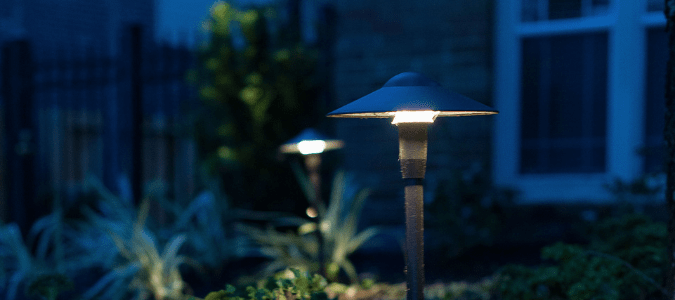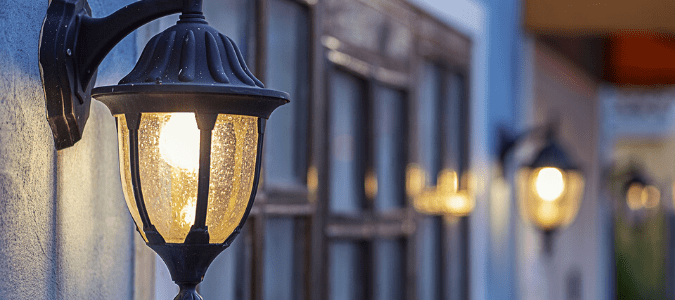
Well-placed lights around your pool area can enhance the beauty of your backyard and help you get the most out of your investment, day or night. In addition, installing landscape lighting can illuminate walkways to help your swimmers find their way from your back door to your pool more safely. Some common options include lights next to a patio, pergola, seating area, walls or perimeter. Additionally, lighting on water features, trees, plants, garden beds, decorations or statues can help create a welcoming atmosphere and accent certain areas of your property.
If you’re considering adding to the aesthetics and function of your pool area through lighting, you’ll want to keep some other considerations in mind. For instance, if you choose lighting that’s too bright or harsh, then you can inadvertently ruin the casual and serene atmosphere you’re probably trying to achieve. In some situations, low-voltage LED lighting can effectively provide the extra light you need without causing an annoying glare or ruining the ambiance. This type of energy-efficient lighting can also save you over time on your electric bills.
Another option you might want to investigate is solar lighting. In addition to using a low amount of energy, these types of lights are also a convenient way to safely illuminate various parts of your yard because they typically don’t need to be plugged in or wired to your electric system.
Other aspects to think about are the light beams’ spread and color. Homeowners can use colored lights instead of the traditional white lights around or in a pool to create a certain mood or soften lighting. In addition, using a variety of lighting techniques can achieve different effects, including:
- Moon lighting: By mounting a light in a tree or other high area and aiming it down towards the ground, you can create the effect of the moon shining down on your pool and yard.
- Washing: By using wide-beamed lighting along walls, hedges and other large spaces in the yard, you can essentially “wash” the area in light.
- Shadowing: By shining a light at a bush, water fountain or another item with a wall or other surface behind it, you can highlight specific objects and interesting shapes, create a beautiful shadow and produce a soft lighting effect.
- Silhouetting: This technique, also known as backlighting, involves placing a light behind an object and projecting the light out to dramatically accent the object.
- Grazing: Similar to washing, grazing helps provide light to a large surface, but it is more subtle because it is often focused on a more specific area to help provide depth to architectural features. With this technique, you still shine the light up or down on the area you want to illuminate, but you install the lights much closer to the wall or other surface to limit the lighting spread.
- Mirror lighting: This involves strategically lighting areas near your pool or other water features in such a way that the reflection off the water allows you to see a double image.
- Up lighting: This is a technique where you install a light in the ground or another low area and shine it up onto a tree, fountain or other taller object. This helps highlight certain areas of your yard and can help improve safety by illuminating dark areas around the pool.
The best way to determine which of these lighting techniques is best for your yard and to make sure your lights are installed safely and correctly is to work with a professional. Experienced technicians can install your outdoor lighting just the way you want it and make sure that all your lighting components are thoughtfully planned and arranged.
While homeowners can install some types of lights, like solar or battery-operated lighting, working with electricity can pose a serious risk to homeowners who lack the proper training and experience to take on more complicated projects. A professional can take care of all your lighting needs for you and help you create the safe and beautiful outdoor space you’re looking for. Additionally, landscape designers can often also help with other aspects of your yard, such as suggesting evergreen shrubs to add privacy, creating a pathway or walkway and adding in water features that can enhance your enjoyment of your space.
Deciding how you want to illuminate your yard is just one step in the landscape lighting process. Keep reading to learn about different types of landscape lighting and what steps are involved in creating a landscape lighting plan.

Types of Landscape Lighting
The types of landscaping lighting that professionals often recommend homeowners install around pools include:
- Directional lights or spotlights. You can point these lights up or down to show off a specific object or area like one end of the pool, gorgeous flowers, a statue, a waterfall, your prized cactus collection, a wall or a pretty tree.
- Floodlights. These lights can help illuminate a large area, such as a seating space, the whole pool or an entire wall. They’re good for providing safety and security to an area, but if they aren’t focused properly, they can create a harsh effect in your yard and might disrupt your neighbors.
- Deck and patio lights. Lighting in these areas is often functional because it helps people avoid falling while walking in and around your pool area. It also helps provide adequate light for other essential backyard activities, such as visiting with friends and family or grilling. These accent lights can also help add to the atmosphere you’re trying to create in your outdoor space. For example, hanging string lights along the top of your pergola or around your deck railing can help make even a quiet night at home seem like a party. If you choose to use string lights, they are high enough to reduce the risk of a family member, guest or pet getting caught in or tripping over them.
- Hardscape lights. You can embed these lights in steps, pathways, and other landscaping features. Hardscaping lighting helps people see where they’re walking while also reducing the glare that other types of lighting might produce. However, if the lights are too subtle or pointed at too small of an area, they might not provide the visibility you need to walk safely through your yard.
- In-ground or well lights. These lights are either flush with the ground or stick up a bit and shine up to illuminate or highlight a certain area. If they’re installed and pointed correctly, they can be a great way to add light without having a bunch of wires visible across your yard. However, in-ground lights can also be a dangerous obstacle while mowing. If the lights aren’t directed properly, they might also inadvertently shine in a guest’s eyes while they’re trying to walk to the pool.
- Path lights. Similar to hardscaping, path lighting helps people see where they’re going, but they typically provide light to a larger area. Some types of path lights include post lights that shine down on a path or battery-operated torches that illuminate the walkway with a festive touch.
- Underwater lighting. Lights beneath the surface of your pool can make it easier for swimmers to enjoy a dip after the sun goes down. Underwater lights can also help highlight these water features. For example, underwater lighting in a fountain can make it even more beautiful, or lights in an ornamental koi pond can help draw attention to fish and plants.
It can be difficult for homeowners to know which types of lights are right for their backyard, but a professional landscaping company with experience in outdoor lighting services can help make the process easy and efficient. They can handle all of the landscaping details for you, so you can focus on just enjoying the end result.

Creating a Landscape Lighting Plan
Creating a plan before you start installing lights around your pool can help you get the most out of your outdoor space. The first step in making this landscaping plan is coming up with a list of your goals. Do you want to make it easier to navigate around your yard at night? Does your home insurer require you to have a certain level of lighting around your pool? Are you trying to create a certain atmosphere?
The next step is making a sketch of your yard that shows the pool, as well as any sheds or structures, greenery and other decorations. This will help you decide where you want the lighting to go and which type of lights you might need.
If you’re planning to use any type of lights that require electricity, you’ll also want to consider where your outlets are currently located and map out where you’ll need additional electrical lines. It’s also critical to think about how much money you’d like to spend, since this can limit what kind of lights and how many lights you’ll be able to install.
The landscape planning process can seem overwhelming for homeowners with little or no experience in lighting or landscaping, but you don’t have to handle this on your own. For a complicated landscaping project like this one, it is usually worth it to hire a landscaping professional who can do all the hard work for you and take your project from the planning phases through execution. Furthermore, landscaping professionals can help with other projects, such as landscaping with drought-tolerant plants, so that your yard stays green through the summer heat.
ABC Can Beautify Your Backyard
There are a lot of things to consider when installing outdoor lighting. Between choosing the type of lighting, making sure you’ll have enough electrical power for the lights and actually installing the lights, homeowners quickly realize that this is no easy landscaping project. Fortunately, the landscaping professionals at ABC Home & Commercial Services can simplify the process by doing the hard work for you. Whether you have an idea of what you want or you need a little inspiration, our pros can help every step of the way. We even offer spring cleanup services, so your backyard will be ready for neighborhood barbecues, dinner parties and pool parties once it’s warm enough to swim.